|
Dave Harris [Much-cited source in Deleuze's book in Bacon. Rather clearer than Deleuze. Another reminder of Badiou's critique that Deleuze discovers only what he has thought already when he adds philosophy to detailed analysis -- in this case the diagram as well as the BwO and becoming-animal]. The history of art is really a history of misunderstanding, and that applies particularly to Cézanne. His influence has been unparalleled, however, but it is more than just 'novel kind of fragmentation, the development of discontinuity into pattern, or the elevation of concords of colour and line into harmonies that were sufficient in themselves' (180). A major influence was a concern with 'the existent world' (181) as well. He painted objects rather than effects, and the influence of his native countryside is apparent. Colour does become more important later, but still as an attempt to depict 'the breadth and depth of nature'. It was not Impressionism, despite signs of an influence. Nor is it the same as 'the object – based structures of earlier years'. He was a modernist, but in terms that did not and still does not exist. The apparent discontinuity and fragmentation actually suggested 'ways of perception and patterns', although he did not see himself as succeeding There are 'different kinds of rationale' (182) in the earlier and later work. One stressed a 'logical mimetic theory of painting', while the other depended on 'inherent meanings', 'a way of thought rather akin to free association'. It is not clear whether Cézanne intended this — some of his remarks indicate equivocation and 'aesthetic doubletalk'. He displays 'contradictory kinds of reference' that are still widespread, despite his commitment to 'earnestness' and the 'moral dignity of tradition'. Cézanne himself was preoccupied with theory and explanation. The questions are still relevant. Although Cézanne was 'passionately attached to objects', he also moved towards 'the disintegration of the object' especially in the last phase. The patch of colour replaces the object. He worked on this before, for example originally using palette knives: that had been generally associated earlier with 'an attachment to what was actual and physical' (183), but Cézanne wanted to paint with the knife throughout, thinking that 'the handling was the picture'. A new 'intrinsic material unity' emerged which links the picture to objects but also to the 'common consistency of the material world'. A new aesthetic emerges in the late 1860s, involving 'extreme standpoints and total solutions', and it is this that finally separated out the avant-garde, including Cézanne. Patches of colour with straight edges reappeared, as in L'Etang des Soeurs (below) but colour differentiation became 'the chief medium of definition'. We see in this picture parallel alignments of colour patches offering a kind of early version of a structure, and this was to reappear in later works, including watercolours which had 'eliminated the material substance that remained' (184). Objects in space became 'apparently immaterial relationships of colour', appearing in the oil painting as well. An area was composed of vertical brushstrokes, delicately graded in colour and then more differentiated 'like detached facets'. These still had a figurative function, however. Cézanne himself agreed this, in his own way: we interpret nature as a series of patches of colour 'following one another according to a law of harmony'. These hues are understood as having modulations. In this way painting 'is classifying' sensations of colour. Cézanne was precise in his terminology and was generally well educated, so terms like harmony and modulation should be seen as part of a system, although he was occasionally 'more literary and fanciful'. [L'Etang is a transitional piece] 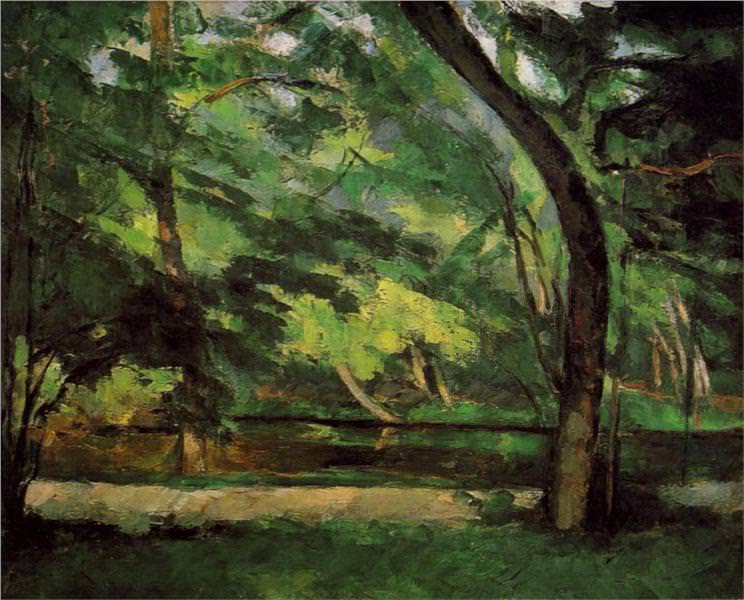 Later, there is tonal homogeneity, like Impressionism, but the colour patches do not mould the form. The physical shapes of the earlier paintings do not persist: 'the structure is no longer one that we can imagine built. It is a property of the juxtaposition of colours on the flat surface' (185). Cézanne began to talk about the work of the eye, and the way in which it operated with a 'culminating point', always closest to the eye. The discussion that nature models itself on spheres and cylinders, was not to be taken literally — even flat surfaces could be seen like this. The line of sight meets a flat surface at different angles, and this is not really different from viewing a rounded surface. The 'geometry of vision' displays a common property. The use of modulated different colours, instead of monochrome flat spaces to depict objects is an example of this view that nature operates with circular forms [the modulations apparently vary the angles of lines of sight]. Angles of sight always vary, even with lines that are actually straight. This might explain why straight lines become curves as 'compensation'(186), a rejection of plane perspective. However, he was guided as much by theory as observation, and once explained that a sense of colour was developed by both work and 'by reasoning', responding to needs that were 'both emotional and intellectual'. Modulations of colour were intellectually necessary, and offered a continuing form of modelling. This looks like abstraction, but Cézanne insisted there was still a 'systematic figurative function', not descriptive but 'expository'. This appeared first in the watercolours and began in the 1880s. Gowing understand it as 'progressive process of sublimation'. The material characters were less important, so the new images looked ascetic, subordinated to designs, structural rather than matters of 'sensuous enrichment', akin to buildings. We see this in an 'exceptional' watercolour The Green Pitcher: 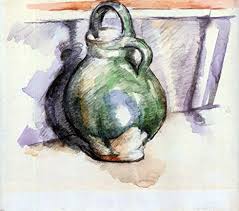 Here is what Gowing says of this: the culminating point is not a highlight on the front of the pots but a blank piece of canvas. Then the colours are arranged in order blue, green 'the material colour of the pot' then ochre. Here, 'a deliberate system is being employed… No pot ever produced this logical sequence' it is the colour sequence that produced 'the lightness of the spot'. There is also a spot of red at the base and an asymmetrical line, providing 'stance' and 'pictorial poise' respectively. The whole painting shows the method and way of thought that was to be developed and elaborated later. For example we see colour sequences which are 'increasingly independent of direct transcription of sense data' [the example is a portrait of Cézanne's wife] (188). The colours are presented 'abruptly' and are not 'continuous modelling in light and dark. They convey the rounded surface metaphorically'. We see the same sort of development in the first series on Mont Sainte-Victoire. It is an emergent logic in the order of colour rather than 'anything one can imagine observing on the spot'. In the later paintings, 'related colour mutations were noted in groups of brushstrokes in contrasting directions, beginning to form into discrete patches, with no reference to separable objects'. Later paintings was even more 'systematic and more detached'. Watercolour avoided 'implications of material substance'. Colours were always presented in the order of the spectrum, with regular intervals ending in a culmination point and then reversed. This produces both 'melodic response' and 'the continuous curvature of the surface'. Cézanne was to make explicit his notion that it is the contrast in connection of colours that is central to modelling, and he assume that nature was also 'modelled on forms with a rounded section'. There were occasional complications from superimposition, and some experiment with the watercolours, but the underlying principle remained, to replace light and shadow by 'changes of surface and the ideal roundness of mass as if in a code' (189). But this was not an artificial symbolism, rather a matter of 'natural, almost physical reactions to the relationships and the contrasts inherent in intervals of colour'. An observer [and later recipient of thoughts, one Emile Bernard] saw the method in action. Cézanne began with a single patch which was then overlapped to produce a hinging effect which not only colours the object but moulds its form. There was '"a law of harmony that directed his work"' with modulations '"fixed beforehand in his mind"'. Apparently, '"he deduced general laws, then drew from them principles"' to guide his interpretation. '"His vision was much more in his brain than in his eye"'. Later work shows the effect of definite motifs, but even here patches of colour were organized in the same way [the example is a watercolour of rocks, or other topics — in these, we are offered 'deepening echoes of a single progression; in both it is the colour not the description makes the form'. Cézanne himself was to confide in Bernard that the point was to stress modulation not modelling, although the French word might imply both. There might also have been a musical analogy. Modulation means a 'transition through clearly perceptible stages', but Cézanne rejected 'smooth monochromatic modelling, although later work might include using colour to indicate changes in the direction of shapes, or scale. Whatever, 'the possibilities enough to show that this is a procedure in which reason and calculation are inseparable from the poetics' (190), and there is no 'direct reliance on empirical data'. Gowing sees it as the result of Neoplatonism — '"theory developed and applied in contact with nature"'. An example here is Bridge under Trees [it might be this one?]. Gowing says that there is no specific local colour, but rather a series based on green and blue, as 'an equivalent to the great blossoming of form'. It was painted at a time when Cézanne saw art as '"a harmony parallel with nature"'. Again this draws on ideas going back to antiquity [Deleuze specifically broke with all those, of course]. 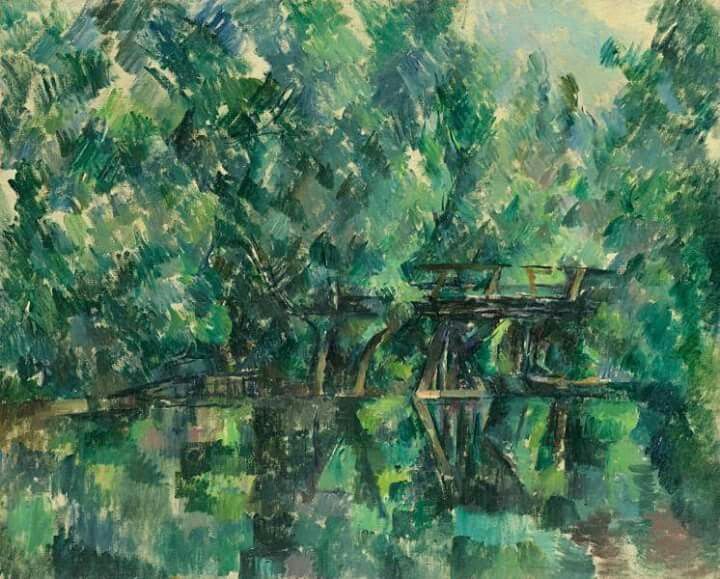 So, by the
end of the 1890s, Cézanne was using oil
painting for observations of nature, and
watercolours for 'metaphoric sequences of
colour, which operated through the gradations
of colour interval rather than identifying any
local hue or effect' (191).[I could not find
the examples on the web, so I reproduce them
from Gowing page 191]. Gowing says that the
watercolour shows 'a key of blue modulating
into yellow and pink'which became 'a
conventional system for the notation of the
actual bulk'. He also used pyramid
formulations or diamond-shaped's, reinforced
in the oil painting by the wallpaper. The oil
painting looks more real but is 'in fact more
schematic', with straighter lines and flat
planes. The colours in the watercolour
attempted 'to grasp of the actual volumes; it
was a digestive system' and after the solidity
had been grasped, the schematic structure was
possible. We see therefore 'two processes,
analytic and synthetic' (192), explaining the
'immense labour, indeed the eventual
impossibility of completing a picture'. The
method became increasingly deliberate.
[Then a bit which Deleuze cites, where a patch on the portrait of Vollard was left deliberately blank and when asked, Cézanne says that he would struggle to find the right colour to fill the spaces, and that once he did he would have to go over the whole picture again]. The point is that relationships of colour are crucial, 'akin to the physical articulation of forms' in some of the drawings. 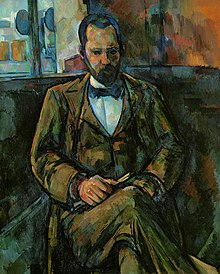 After 1900, Cézanne became increasingly figurative, but never entirely, nor never just parallel with nature. Indeed, the figurative style is 'so magical that he has come to glory in it is an order of reality in itself' (193). We see this with the increasing tendency to focus on segmented surfaces, say with foliage, 'an absolute intoxication with colour contrast is an order of reality in itself, a complete world'. Cézanne said there was no other task for painting, not line or modelling, a 'self-sufficient fabric of colour contrast'. Cézanne persisted with metaphorical sequences of colour however to depict volume, even in some of the oil painting.Gowing describes the House on the Hill as having a number of successive culmination points with sequences arranged around them in spectrum order e.g. 'emerald, cobalt, the bluegrey culmination and violet', or crimson succeeded by red pink and golden oak. The system is used elsewhere too. 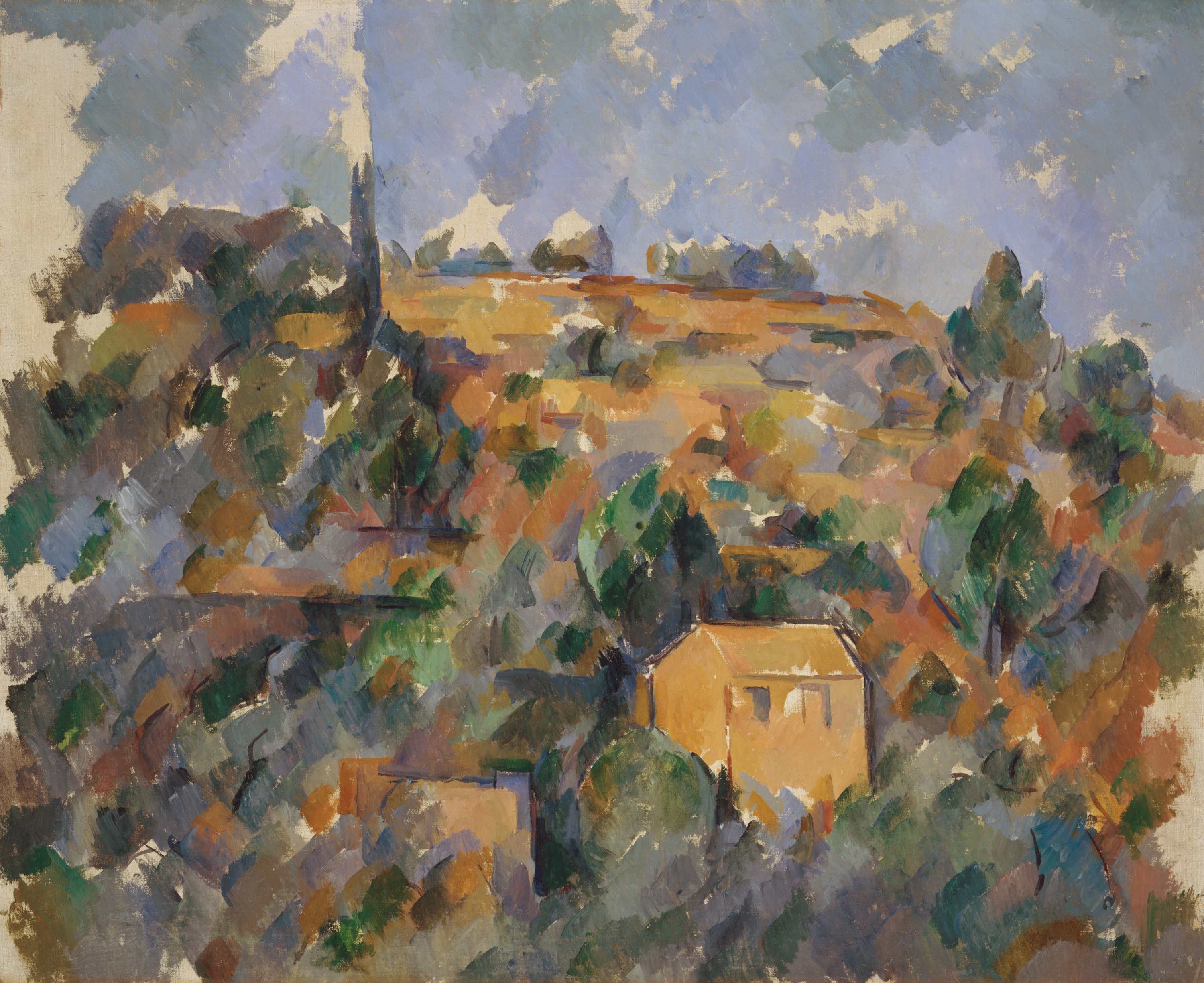 Cézanne was determined to 'read nature', to realise it in his terms. This meant realising the sensations both personal and traditional, to interpret nature in terms of patches of colour. He explicitly defined these terms in his theory, although Cézanne was not primarily interested in the correctness of theory. Nevertheless to paint required 'both a way of seeing and a system of thought' (194), and both were inseparable: logic related to the organisation of sensations '"which provides the means of expression"'. Sensations were 'the root of everything' (195), and seem to include both sight data and feelings. He was proud of them, and served as a basis to defend his stance. There is some ambiguity, however. They might be organised by logic and in that sense go beyond mere sense data, the stuff of mere perception. Cézanne wanted to reawaken '"confused sensations"' which we have originally, to revive our instincts and artistic sensations. At the end of his life, they became identified as sensations of colour, again seen 'as much innate as experienced'. The struggle was to realise them Cézanne originally took realisation to mean 'simply the satisfaction of natural wishes' (196). Difficulties arose, however, for example in the tendency for the erotic drive to become 'sublimated in the pursuit of a consummation in art', a special notion of realisation, evoking emotions and unsatisfied longings. He was a lonely person. What must be realised is not just the 'actuality of nature', which the artist merely depicts. There may well be a basis in observation, combined with a love of nature, but Cézanne opposed photographs and accurate drawing, 'the whole conception of representation is a reflex action' without intellectual activity, allowing the eye to direct the hand '"without reason intervening"'. Representation was not the same as reproducing. He preferred the notion of interpreting instead of representing, although he was also well aware of traditional conceptions involving imitation and even artistic deception. The point was to make things real. First of all the model had to be read, form traced or construed and then realised, a much slower process. Imitation did not deliver reality in painting, and the focus had to be what was 'intrinsically real'. (197). This involved logically organising and classifying sensations. The debate between copying objects and realising sensations was in fact an earlier one [discussed 197]. Intrinsic reality turned on the sense of colour that was both 'inborn and confirmed from nature' (198), and subject to logic, organisation and classification. It could be thought of as using sequences of colours to interpret volume, with colour patches ordered by the spectrum and spaced evenly along it: this could be the 'law of harmony', rather like using a particular key and scale. Cézanne saw it as 'an inborn visual syntax' Cézanne face difficulties including those provided by age and ill-health, and a tendency to see himself as a Moses. Cézanne saw the pain of realisation and intensity as 'part of the triumph': painting had to make real in a way that 'would parallel nature and its harmony and follow it in structure'. This required magnificent colour, something the animated nature and life itself. He saw the life of nature as inside himself, as the result of some 'imperative emotional need' (199). These uses of colour characterise the last works, including the still lives, depicting 'sombre resonances' of colour — 'the polarity of ginger and violet or orange and blue green' (200). There is material richness in the objects depicted. The colours are not intended to generate an atmosphere but reflect 'a specifically pictorial pressure between complementary colours' [the characteristic example is Still Life with Apples and Peaches. More examples on 201]: 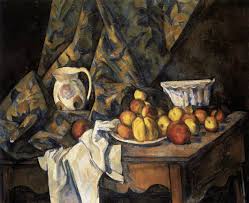 Another example of colour modulation is Nature morte: Pommes, poires et casserole: 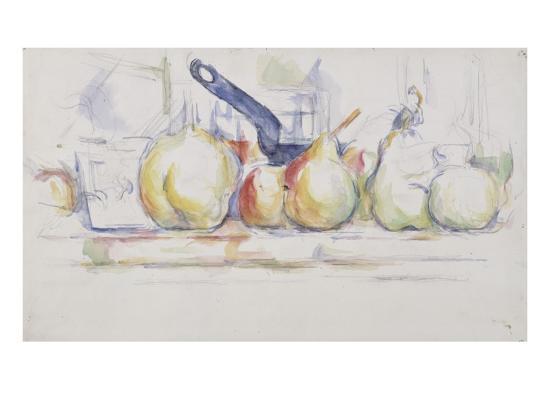 Here,
says Gowing, is 'astonishing brightness'
and a progression of primary colours from
red to yellow to green to blue. The
culminating point is the violet blue
handle. The formal content is also 'so
physical and sensual', an example of
'biomorphic modelling' found elsewhere.
In his old age, Cézanne was increasingly subject to mortification but obstinacy. We can see a sublimation in the biomorphic shapes [the example is Rocks near the Caves above Château Noir]. The setting provoked thoughts about 'the diversity and complication of nature'(203) which resisted reason, although his own personal confusions of sensation were a problem as well. It was necessary to somehow represent 'the manifold image of nature'. A new 'dichotomy of style'also emerged, based on some emotional issue, and seen between 'bulging biomorphic rhythms' and 'light yet calculated precision with which colour patches are built'. Together, we see how 'rectilinear structures [organising the colour patches]… Sublimated the physical and sensual content of form into the successions of chromatic intervals'. There may have been a therapeutic benefit: being able to realise sensations like this became 'the prerequisite of his own sense of identity', and when it worked, he felt himself stronger than others: at other times a helpless victim of himself, needing friends, suffering from black moods. Mastering oneself involved command of the subject and means of expression. That in turn depended on '"a good method of construction"' (204). Eventually, logical readings of nature became a matter of survival itself. Cézanne's sequences of colour patches should not be mistaken for those in other styles. They 'do not represent materials or facets or variations of tint. In themselves they do not represent anything'. It is the relationships between them that counts, progressions and modulations and these 'parallel the apprehension of the world'. The colours imply not only volumes but 'axes, armatures', often at right angles to chromatic progressions a kind of 'invisible upright scaffolding' [the portrait of the gardener is the example.Some of the paintings of trees forming a vault also use wedges of colour to indicate both foliage and 'the imagined structures implied' (205). Much depends on 'implications of gradient that are is naturally inherent in colour intervals as in music intervals'. We are not talking about reference but a 'psychology of vision'. The patches must be large enough to stay perceptible in their own rights. There is also an earlier 'linear flourish that marked the passion of the figurative act'. 'Descriptive rightness in an image' could affect the artists detachment and his autonomous reaction to nature. Instead, the right sort of brushstrokes and colours would produce the drawing themselves, 'an image is the product not of an act of will, but of a process that was analogy used to the automatism of nature'. The series of paintings of Mont Sainte-Victoire [discussed in more detail 206 – 9 begins with a depiction of local colours and conventional light and shadow, tangible modelling. Then there are gentler versions, still with light and dark and 'highly specific drawing of contours'.. Other images show the full chromatic code 'a continuous band of colour modulation'. There are 'parallel vertical brushstrokes that unite the canvas', with patches arranged along the horizontal lines, deliberately chosen to offer human depth and breadth respectively, drawing upon earlier traditions, perhaps. Later painters like the Cubists would build 'the human role vertically into the conception of an image' (207). There is 'surface homogeneity', and landscapes 'reimagined in bands of colour modulation with sharp contrasts'., Although still with some 'material realism': the sky, for example is rendered nonnaturalistic the, and the same colours as the landscape, although material differentiations of substance are still apparent. Eventually, the consistent range of colour dominates, and linear marks do not define anything. 'Affinity and correspondence in themselves' (208) become important. Finally, the system of colour embodies all form, with horizontal parabolas representing the real, despite flat surfaces, an abstraction for Gowing. Cézanne acknowledged that abstractions were necessary because he could not cover canvases entirely or look at objects with delicate points of contact, although he still criticised the practice of describing contours with a line, and thought that nature would provide the solution. Cézanne
turned back to consult nature in the
last years, especially at
Fontainebleau, where 'combinations of
light atmosphere and natural shape'
helped him with an analytical reading.
The example here is Le Chateau a
Fontainebleau
u 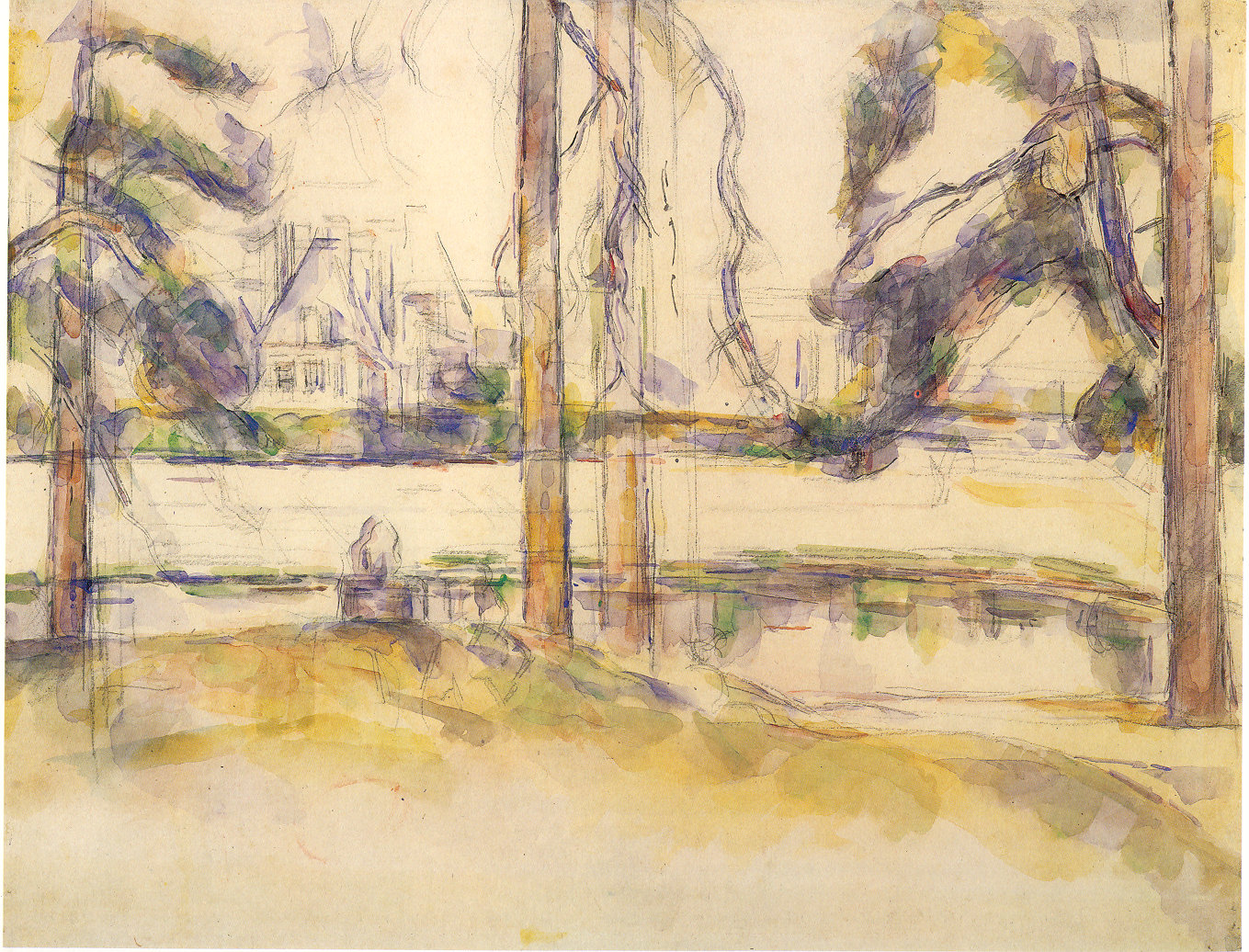 GowingSays
we see a restless linear definition, tree
trunks moved through successive positions
to adjust the view, a 'deceptively
traditional look' (209), but also 'an
advanced and complex abstraction' (210)
which include not only a colour sequence
but 'a graphics system too — a linear
code' [I think the argument is that
Cézanne was trying to dominate nature more
at this stage. There are other examples of
'sharp and wiry' brushstrokes on 210, some
returning to the Mont St Victoire series].
We see some other structures like echoing
shapes or progressions of colour between
foregrounds and backgrounds. Sometimes
colours are splintered 'with no
three-dimensional connotation', but also
'the wiry line out of which the contour is
woven' (211).
In the last watercolours, 'correspondences of colour melt together'. Things are no longer separated, differences are reconciled, a gentler kind of 'mild luminosity' reflects the painter's own pleasure. There is also 'prophetic grandeur'. Overall, Cézanne insisted that 'the process [of developing from past histories] is rational and sensible' (212). Painting was 'of an art of rational intelligibility'… '"Simply the means of making the public feel what we feel ourselves" close ' |